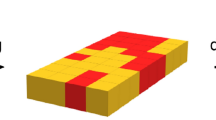Abstract
We introduce the problem of staged self-assembly of one-dimensional nanostructures, which becomes interesting when the elements are labeled (e.g., representing functional units that must be placed at specific locations). In a restricted model in which each operation has a single terminal assembly, we prove that assembling a given string of labels with the fewest steps is equivalent, up to constant factors, to compressing the string to be uniquely derived from the smallest possible context-free grammar (a well-studied O(log n)-approximable problem) and that the problem is NP-hard. Without this restriction, we show that the optimal assembly can be substantially smaller than the optimal context-free grammar, by a factor of \(\Omega(\sqrt{n/\log n})\) even for binary strings of length n. Fortunately, we can bound this separation in model power by a quadratic function in the number of distinct glues or tiles allowed in the assembly, which is typically small in practice.





Similar content being viewed by others
Explore related subjects
Discover the latest articles, news and stories from top researchers in related subjects.Notes
Personal communication with Hyunmin Yi, 2008–2010.
References
Harish C, Nikhil G, John R (2009) The tile complexity of linear assemblies. In: ICALP 2009, vol 5555 of Lecture notes in computer science, pp 235–253
Charikarv M, Lehman E, Liu D, Panigrahy Rina, Prabhakaran M, Rasala A, Sahai A, Shelat A (2002) Approximating the smallest grammar: Kolmogorov complexity in natural models. In: Proceedings of the 34th Annual ACM Symposium on Theory of Computing. ACM, New York, NY, USA, pp 792–801
Czeizler E, Popa A (2012) Synthesizing minimal tile sets for complex patterns in the framework of patterned dna self-assembly. In: DNA computing and molecular programming, vol 7433 of Lecture notes in computer science, pp 58–72
Demaine E, Demaine M, Fekete S, Ishaque M, Rafalin E, Schweller R, Souvaine D (2008) Staged self-assembly: nanomanufacture of arbitrary shapes with O(1) glues. Nat Comput 7:347–370
Farach M, Thorup M (1998) String matching in Lempel–Ziv compressed strings. Algorithmica 20:388–404
Göös M, Orponen P (2011) Synthesizing minimal tile sets for patterned dna self-assembly. In: Yasubumi S, Yongli M (eds) DNA computing and molecular programming, vol 6518 of Lecture notes in computer science. Springer Berlin, pp 71–82
Kao M-Y, Schweller R (2008) Randomized self-assembly for approximate shapes. In: ICALP 2008, vol 5125 of Lecture notes in computer science, pp 370–384
Kieffer J, Yang EH, Nelson G, Pamela C (2000) Universal lossless compression via multilevel pattern matching. IEEE Trans Inf Theory 46:1227–1245
Lehman E (2002) Approximation algorithms for grammar-based data compression. PhD thesis, MIT
Ma X, Lombardi F (2008) Synthesis of tile sets for dna self-assembly. IEEE Trans Comput Aided Des Integr Circuits Syst 27(5):963–967
Rytter W (2002) Application of Lempel–Ziv factorization to the approximation of grammar-based compression. In: Alberto A, Masayuki T (eds) Combinatorial pattern matching, vol 2373 of Lecture notes in computer science. Springer, Berlin, pp 20–31. doi:10.1007/3-540-45452-7_3
Sakamoto H (2005) A fully linear-time approximation algorithm for grammar-based compression. J Discret Algorithms 3(2–4):416–430
Soloveichik D, Winfree E (2005) Complexity of self-assembled shapes. In: Ferretti C et al. (eds) DNA computing, vol 3384 of Lecture notes in computer science, pp 344–354
Winfree E (1998) Algorithmic self-assembly of DNA. PhD thesis, Caltech
Acknowledgments
We thank Martin Demaine, André Schulz, Diane Souvaine, and Hyunmin Yi for helpful discussions, and anonymous reviewers for helpful suggestions.
Author information
Authors and Affiliations
Corresponding author
Rights and permissions
About this article
Cite this article
Demaine, E.D., Eisenstat, S., Ishaque, M. et al. One-dimensional staged self-assembly. Nat Comput 12, 247–258 (2013). https://doi.org/10.1007/s11047-012-9359-0
Published:
Issue Date:
DOI: https://doi.org/10.1007/s11047-012-9359-0




